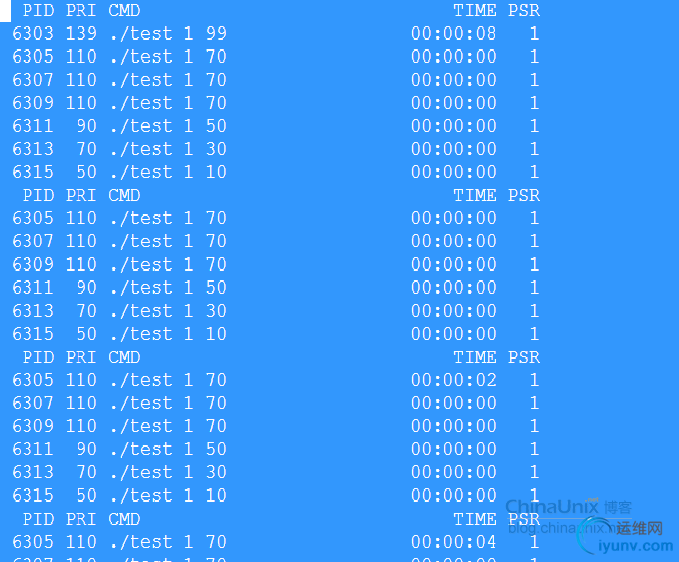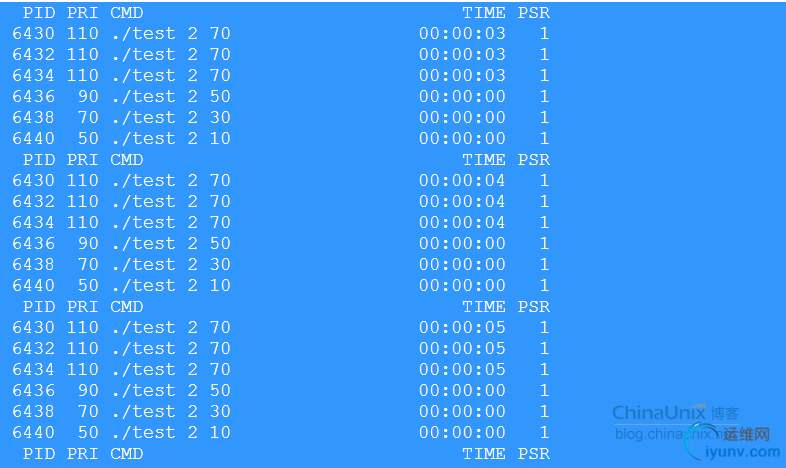|
|
作者:manuscola.bean@gmail.com
int sched_setscheduler (pid_t pid,
int policy,
const struct sched_param *sp);
sched_setscheduler函数的第二个参数调度方法 :
- #define SCHED_OTHER 0
- #define SCHED_FIFO 1
- #define SCHED_RR 2
- #ifdef __USE_GNU
- # define SCHED_BATCH 3
- #endif
SCHED_OTHER表示普通进程,对于普通进程,第三个参数sp->sched_priority只能是0
SCHED_FIFO 和SCHED_RR表示实时进程的调度策略,第三个参数的取值范围为[1,99]。
如果sched_setscheduler 优先级设置的值和调度策略不符合的话,会返回失败的。
内核中有这么一段注释:
- /*
- * Valid priorities for SCHED_FIFO and SCHED_RR are
- * 1..MAX_USER_RT_PRIO-1, valid priority for SCHED_NORMAL,
- * SCHED_BATCH and SCHED_IDLE is 0.
- */
LINUX系统提供了其他的系统调用来获取不同策略优先级的取值范围:
- #include
- int sched_get_priority_min (int policy);
- int sched_get_priority_max (int policy);
另外需要指出的一点是,应用层和内核层的优先级含义是不同的:
首先说实时进程:实时进程的优先级设置可以通过sched_setsheduler设置,也可以通过sched_setparam设置优先级的大小。
- int sched_setparam (pid_t pid, const struct sched_param *sp);
在用户层或者应用层,1表示优先级最低,99表示优先级最高。但是在内核中,[0,99]表示的实时进程的优先级,0最高,99最低。[100,139]是普通进程折腾的范围。应用层比较天真率直,就看大小,数字大,则优先级高。ps查看进程的优先级也是如此。有意思的是,应用层实时进程最高优先级的99,在ps看进程优先级的时候,输出的是139.
下面是ps -C test -o pid,pri,cmd,time,psr 的输出:
- PID PRI CMD TIME PSR
- 6303 139 ./test 1 99 00:00:04 1
虽说本文主要讲的是实时进程,但是需要插句话。对于普通进程,是通过nice系统调用来调整优先级的。从内核角度讲[100,139]是普通进程的优先级的范围,100最高,139最低,默认是120。普通进程的优先级的作用和实时进程不同,普通进程优先级表示的是占的CPU时间。深入linux内核架构中提到,普通优先级越高(100最高,139最低),享受的CPU time越多,相邻的两个优先级,高一级的进程比低一级的进程多占用10%的CPU,比如内核优先级数值为120的进程要比数值是121的进程多占用10%的CPU。
内核中有一个数组:prio_to_weight[20]表示的是默认优先级120的权重,数值为1024,prio_to_weight[21]表示nice值为1,优先级为121的进程的权重,数值为820。这就到了CFS的原理了
- static const int prio_to_weight[40] = {
- /* -20 */ 88761, 71755, 56483, 46273, 36291,
- /* -15 */ 29154, 23254, 18705, 14949, 11916,
- /* -10 */ 9548, 7620, 6100, 4904, 3906,
- /* -5 */ 3121, 2501, 1991, 1586, 1277,
- /* 0 */ 1024, 820, 655, 526, 423,
- /* 5 */ 335, 272, 215, 172, 137,
- /* 10 */ 110, 87, 70, 56, 45,
- /* 15 */ 36, 29, 23, 18, 15,
- };
假如有1台电脑,10个人玩,怎么才公平。
1 约定好时间片,每人玩1小时,玩完后记账,张XX 1小时,谁玩的时间短,谁去玩
2 引入优先级的概念,李四有紧急情况,需要提高他玩电脑的时间,怎么办,玩1个小时,记账半小时,那么同等情况下,李四会比其他人被选中玩电脑的频率要高,就体现了这个优先级的概念。
3 王五也有紧急情况,但是以考察,不如李四的紧急,好吧,玩1个小时,记账45分钟。
4 情况有变化,听说这里有电脑,突然又来了10个人,如果按照每人玩1小时的时间片,排在最后的那哥们早就开始骂人了,怎么办?时间片动态变化,根据人数来确定时间片。人越多,每个人玩的时间越少,防止哥们老捞不着玩,耐心耗尽,开始骂人。
这个记账就是我们prio_to_weight的作用。我就不多说了,prio_to_weight[20]就是基准,玩一小时,记账一小时,数组20以前的值是特权一级,玩1小时记账20分钟之类的享有特权的,数组20之后是倒霉蛋,玩1小时,记账1.5小时之类的倒霉蛋。 CFS这种调度好在大家都能捞着玩。
扯到优先级多说了几句,现在回到正题。我将上面的C程序编译成可执行程序test,然后写了一个脚本comp.sh。
- [iyunv@localhost sched]# cat comp.sh
- #/bin/sh
- ./test $1 99 &
- usleep 1000;
- ./test $1 70 &
- usleep 1000;
- ./test $1 70 &
- usleep 1000;
- ./test $1 70 &
- usleep 1000;
- ./test $1 50 &
- usleep 1000;
- ./test $1 30 &
- usleep 1000;
- ./test $1 10 &
因为test进程有sleep 2秒,所以可以给comp.sh启动其他test的机会。可以看到有 99级(最高优先级)的实时进程,3个70级的实时进程,50级,30级,10级的各一个。
对于FIFO而言,一旦sleep过后,高优先级运行,低优先级是没戏运行的,同等优先级的进程,先运行的不运行完,后运行的也没戏。
对于RR而言,高优先级的先运行,同等优先级的进程过家家,你玩完,我玩,我玩完你再玩,每个进程耗费一个时间片的时间。对于Linux,RR时间片是100ms:
- #define DEF_TIMESLICE (100 * HZ / 1000)
下面我们验证: 我写了两个观察脚本,来观察实时进程的调度情况:
第一个脚本比较简单,观察进程的CPU 占用的time,用ps工具就可以了:
- [iyunv@localhost sched]# cat getpsinfo.sh
- #!/bin/sh
- for((i = 0; i < 40; i++))
- do
- ps -C test -o pid,pri,cmd,time,psr >>psinfo.log 2>&1
- sleep 2;
- done
第二个脚本比较复杂是systemtap脚本,观察名字为test的进程相关的上下文切换,谁替换了test,或者test替换了谁,同时记录下test进程的退出:
- [root@localhost sched]# cat cswmon_spec.stp
- global time_offset
- probe begin { time_offset = gettimeofday_us() }
- probe scheduler.ctxswitch {
- if(next_task_name == "test" ||prev_task_name == "test")
- {
- t = gettimeofday_us()
- printf(" time_off (%8d )%20s(%6d)(pri=%4d)(state=%d)->%20s(%6d)(pri=%4d)(state=%d)\n",
- t-time_offset,
- prev_task_name,
- prev_pid,
- prev_priority,
- (prevtsk_state),
- next_task_name,
- next_pid,
- next_priority,
- (nexttsk_state))
- }
- }
- probe scheduler.process_exit
- {
- if(execname() == "test")
- printf("task :%s PID(%d) PRI(%d) EXIT\n",execname(),pid,priority);
- }
- probe timer.s($1) {
- printf("--------------------------------------------------------------\n")
- exit();
- }
A) FIFO调度策略的输出:
- 终端1 :
- stap ./cswmon_spec.stp 70
- 终端2 :
- ./getpsinfo.sh
- 终端3
- ./comp.sh 1
输出结果如下:

99优先级跑完了,才轮到70优先级,但是虽说有3个70优先级,但是先跑的那个进程跑完了,第二个优先级为70的才能跑。因为输出结果用代码无法漂亮的展示,所以我截了图,截图又不能把这个输出都截下来,所以我很蛋疼。有需要结果的,我以附件形式附在最后。
看下第二个脚本的输出:
- time_off ( 689546 ) test( 6305)(pri= 120)(state=0)-> migration/2( 11)(pri= 0)(state=0)
- time_off ( 689977 ) stap( 5895)(pri= 120)(state=0)-> test( 6305)(pri= 120)(state=0)
- time_off ( 690067 ) test( 6305)(pri= 29)(state=1)-> stap( 5895)(pri= 120)(state=0)
- time_off ( 697899 ) test( 6303)(pri= 120)(state=0)-> migration/2( 11)(pri= 0)(state=0)
- time_off ( 698042 ) test( 6307)(pri= 120)(state=0)-> migration/0( 3)(pri= 0)(state=0)
- time_off ( 699114 ) stap( 5895)(pri= 120)(state=0)-> test( 6303)(pri= 120)(state=0)
- time_off ( 699307 ) test( 6303)(pri= 0)(state=1)-> test( 6307)(pri= 120)(state=0)
- time_off ( 699371 ) test( 6307)(pri= 29)(state=1)-> stap( 5895)(pri= 120)(state=0)
- time_off ( 699392 ) test( 6309)(pri= 120)(state=0)-> migration/3( 15)(pri= 0)(state=0)
- time_off ( 699966 ) events/1( 20)(pri= 120)(state=1)-> test( 6309)(pri= 120)(state=0)
- time_off ( 700034 ) test( 6309)(pri= 29)(state=1)-> stap( 5895)(pri= 120)(state=0)
- time_off ( 707379 ) test( 6311)(pri= 120)(state=0)-> migration/3( 15)(pri= 0)(state=0)
- time_off ( 707587 ) test( 6313)(pri= 120)(state=0)-> migration/0( 3)(pri= 0)(state=0)
- time_off ( 712021 ) stap( 5895)(pri= 120)(state=0)-> test( 6311)(pri= 120)(state=0)
- time_off ( 712145 ) test( 6311)(pri= 49)(state=1)-> test( 6313)(pri= 120)(state=0)
- time_off ( 712252 ) test( 6313)(pri= 69)(state=1)-> stap( 5895)(pri= 120)(state=0)
- time_off ( 727057 ) test( 6315)(pri= 120)(state=0)-> migration/0( 3)(pri= 0)(state=0)
- time_off ( 727952 ) stap( 5895)(pri= 120)(state=0)-> test( 6315)(pri= 120)(state=0)
- time_off ( 728047 ) test( 6315)(pri= 89)(state=1)-> stap( 5895)(pri= 120)(state=0)
- time_off ( 2690181 ) stap( 5895)(pri= 120)(state=0)-> test( 6305)(pri= 29)(state=0)
- time_off ( 2699316 ) test( 6305)(pri= 29)(state=0)-> test( 6303)(pri= 0)(state=0)
- task :test PID(6303) PRI(0) EXIT
- time_off (13057854 ) test( 6303)(pri= 0)(state=64)-> watchdog/1( 10)(pri= 0)(state=0)
- time_off (13057864 ) watchdog/1( 10)(pri= 0)(state=1)-> test( 6305)(pri= 29)(state=0)
- time_off (15333340 ) test( 6305)(pri= 29)(state=0)-> watchdog/1( 10)(pri= 0)(state=0)
- time_off (15333354 ) watchdog/1( 10)(pri= 0)(state=1)-> test( 6305)(pri= 29)(state=0)
- time_off (18743409 ) test( 6305)(pri= 29)(state=0)-> watchdog/1( 10)(pri= 0)(state=0)
- time_off (18743422 ) watchdog/1( 10)(pri= 0)(state=1)-> test( 6305)(pri= 29)(state=0)
- time_off (22154757 ) test( 6305)(pri= 29)(state=0)-> watchdog/1( 10)(pri= 0)(state=0)
- time_off (22154771 ) watchdog/1( 10)(pri= 0)(state=1)-> test( 6305)(pri= 29)(state=0)
- task :test PID(6305) PRI(29) EXIT
- time_off (22466855 ) test( 6305)(pri= 29)(state=64)-> test( 6307)(pri= 29)(state=0)
- time_off (25563548 ) test( 6307)(pri= 29)(state=0)-> watchdog/1( 10)(pri= 0)(state=0)
- time_off (25563566 ) watchdog/1( 10)(pri= 0)(state=1)-> test( 6307)(pri= 29)(state=0)
- time_off (28973602 ) test( 6307)(pri= 29)(state=0)-> watchdog/1( 10)(pri= 0)(state=0)
- time_off (28973616 ) watchdog/1( 10)(pri= 0)(state=1)-> test( 6307)(pri= 29)(state=0)
- task :test PID(6307) PRI(29) EXIT
- time_off (31846121 ) test( 6307)(pri= 29)(state=64)-> test( 6309)(pri= 29)(state=0)
- time_off (32383671 ) test( 6309)(pri= 29)(state=0)-> watchdog/1( 10)(pri= 0)(state=0)
- time_off (32383683 ) watchdog/1( 10)(pri= 0)(state=1)-> test( 6309)(pri= 29)(state=0)
- time_off (35793735 ) test( 6309)(pri= 29)(state=0)-> watchdog/1( 10)(pri= 0)(state=0)
- time_off (35793747 ) watchdog/1( 10)(pri= 0)(state=1)-> test( 6309)(pri= 29)(state=0)
- time_off (39203797 ) test( 6309)(pri= 29)(state=0)-> watchdog/1( 10)(pri= 0)(state=0)
- time_off (39203809 ) watchdog/1( 10)(pri= 0)(state=1)-> test( 6309)(pri= 29)(state=0)
- task :test PID(6309) PRI(29) EXIT
- time_off (41200440 ) test( 6309)(pri= 29)(state=64)-> test( 6311)(pri= 49)(state=0)
- time_off (42613866 ) test( 6311)(pri= 49)(state=0)-> watchdog/1( 10)(pri= 0)(state=0)
- time_off (42613898 ) watchdog/1( 10)(pri= 0)(state=1)-> test( 6311)(pri= 49)(state=0)
- time_off (46024070 ) test( 6311)(pri= 49)(state=0)-> watchdog/1( 10)(pri= 0)(state=0)
- time_off (46024082 ) watchdog/1( 10)(pri= 0)(state=1)-> test( 6311)(pri= 49)(state=0)
- time_off (49434004 ) test( 6311)(pri= 49)(state=0)-> watchdog/1( 10)(pri= 0)(state=0)
- time_off (49434017 ) watchdog/1( 10)(pri= 0)(state=1)-> test( 6311)(pri= 49)(state=0)
- task :test PID(6311) PRI(49) EXIT
可以清楚的可到,同样是70优先级(内核态是29),6305退出以前,6307根本就捞不着跑。同样6307退出一样,6309根本就捞不着跑。这就是FIFO。
B) RR的情况
- 终端1 :
- stap ./cswmon_spec.stp 70
- 终端2 :
- ./getpsinfo.sh
- 终端3
- ./comp.sh 1

实时优先级是70的三个进程齐头并进。再看第二个脚本的输出:
- time_off ( 4188015 ) test( 6428)(pri= 0)(state=0)-> watchdog/1( 10)(pri= 0)(state=0)
- time_off ( 4188025 ) watchdog/1( 10)(pri= 0)(state=1)-> test( 6428)(pri= 0)(state=0)
- time_off ( 7612014 ) test( 6428)(pri= 0)(state=0)-> watchdog/1( 10)(pri= 0)(state=0)
- time_off ( 7612024 ) watchdog/1( 10)(pri= 0)(state=1)-> test( 6428)(pri= 0)(state=0)
- task :test PID(6428) PRI(0) EXIT
- time_off (10679062 ) test( 6428)(pri= 0)(state=64)-> test( 6430)(pri= 29)(state=0)
- time_off (10964413 ) test( 6430)(pri= 29)(state=0)-> watchdog/1( 10)(pri= 0)(state=0)
- time_off (10964422 ) watchdog/1( 10)(pri= 0)(state=1)-> test( 6430)(pri= 29)(state=0)
- time_off (11709024 ) test( 6430)(pri= 29)(state=0)-> test( 6432)(pri= 29)(state=0)
- time_off (12736030 ) test( 6432)(pri= 29)(state=0)-> test( 6434)(pri= 29)(state=0)
- time_off (13779022 ) test( 6434)(pri= 29)(state=0)-> test( 6430)(pri= 29)(state=0)
- time_off (13879021 ) test( 6430)(pri= 29)(state=0)-> test( 6432)(pri= 29)(state=0)
- time_off (13984075 ) test( 6432)(pri= 29)(state=0)-> test( 6434)(pri= 29)(state=0)
- time_off (14084020 ) test( 6434)(pri= 29)(state=0)-> test( 6430)(pri= 29)(state=0)
- time_off (14184023 ) test( 6430)(pri= 29)(state=0)-> test( 6432)(pri= 29)(state=0)
- time_off (14284024 ) test( 6432)(pri= 29)(state=0)-> test( 6434)(pri= 29)(state=0)
- time_off (14374486 ) test( 6434)(pri= 29)(state=0)-> watchdog/1( 10)(pri= 0)(state=0)
- time_off (14374502 ) watchdog/1( 10)(pri= 0)(state=1)-> test( 6434)(pri= 29)(state=0)
- time_off (14384097 ) test( 6434)(pri= 29)(state=0)-> test( 6430)(pri= 29)(state=0)
- time_off (14484066 ) test( 6430)(pri= 29)(state=0)-> test( 6432)(pri= 29)(state=0)
- time_off (14584023 ) test( 6432)(pri= 29)(state=0)-> test( 6434)(pri= 29)(state=0)
- time_off (14684020 ) test( 6434)(pri= 29)(state=0)-> test( 6430)(pri= 29)(state=0)
- time_off (14786032 ) test( 6430)(pri= 29)(state=0)-> test( 6432)(pri= 29)(state=0)
- time_off (14886020 ) test( 6432)(pri= 29)(state=0)-> test( 6434)(pri= 29)(state=0)
- time_off (14986026 ) test( 6434)(pri= 29)(state=0)-> test( 6430)(pri= 29)(state=0)
- time_off (15089023 ) test( 6430)(pri= 29)(state=0)-> test( 6432)(pri= 29)(state=0)
- time_off (15192030 ) test( 6432)(pri= 29)(state=0)-> test( 6434)(pri= 29)(state=0)
- time_off (15292026 ) test( 6434)(pri= 29)(state=0)-> test( 6430)(pri= 29)(state=0)
- time_off (15396085 ) test( 6430)(pri= 29)(state=0)-> test( 6432)(pri= 29)(state=0)
- time_off (15496022 ) test( 6432)(pri= 29)(state=0)-> test( 6434)(pri= 29)(state=0)
- time_off (15596027 ) test( 6434)(pri= 29)(state=0)-> test( 6430)(pri= 29)(state=0)
- time_off (15696153 ) test( 6430)(pri= 29)(state=0)-> test( 6432)(pri= 29)(state=0)
- time_off (15796022 ) test( 6432)(pri= 29)(state=0)-> test( 6434)(pri= 29)(state=0)
用户态实时优先级为99,内核态优先级为0的进程6428退出后,3个用户态实时优先级为70的进程6430,6432,6434你方唱罢我登场,每个人都"唱"多久呢?看相邻2条记录的时间差,基本都在100ms左右,这就是时间片。
后记:如果放开绑定到一个CPU的限制,同时加大实时进程的个数,多个实时进程在CPU之间PULL和PUSH,是更复杂的情况,呵呵,希望抛砖引玉,能有人模拟下这种情况。
附件为测试代码及输出:
study_sched.txt
参考文献
1 深入linux 内核架构
2 linux system program
3 systemtap example |
|